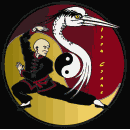
|
“Gao Lung” was originally a form I designed for one of my lady students. The name Gao Lung, a shortened verson of Gaoda de Lung (which means tall dragon) was a play on the student’s first name, Gauhar. For some reason, this form draws a wide
diversity of opinions and comments ... some favorable,
some not. We are not trying to emulate the
movements of a medieval Japanese foot soldier using the
weapon against a mounted attacker, while we recognize
its value in that capacity. We refer to Gao Lung as a
"Naginata" kata because that is generally how a weapon
of this design is recognized in the English
language. Weapons of nearly identical form (but
different names) can be found in virtually all Asian
cultures (and even in European cultures for that matter)
with applications and utilizations reflecting regional
and cultural influences.
|
[Home] [About Us
] [Archie] [Concepts] [Contact Us]
[Gun
Fu Manual] [Kata]
[Philosophy] [Sticks] [Stories] [Web
Store] [Terms of Use]
[Video]
Copyright 2000-2023, Mc Cabe and Associates, Tacoma, WA. All rights reserved. No part of this site can be used, published, copied or sold for any purpose, except as per Terms of Use .
